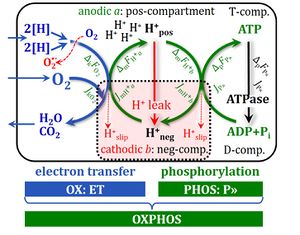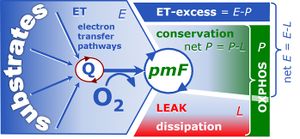From Bioblast
| News and Events | Working Groups | Short-Term Scientific Missions | Management Committee | Members |
COST Action CA15203 (2016-2021): MitoEAGLE
Evolution-Age-Gender-Lifestyle-Environment: mitochondrial fitness mapping
The protonmotive force and respiratory control

OXPHOS-coupled energy cycles. From Gnaiger 2014 MitoPathways.
- » WG1 Action - WG1 MITOEAGLE protocols, terminology, documentation: Standard operating procedures and user requirement document: Protocols, terminology, documentation
- » WG1 Project application

Capacities of the electron transfer system, oxidative phosphorylation and resting LEAK respiration (ETS, OXPHOS, LEAK) and four-compartmental OXPHOS model. (i) Capacity of the ETS module, E, in the noncoupled state, generating the protonmotive force, Δpmt. OXPHOS capacity, P, is partitioned into (ii) the dissipative LEAK component, L (disspation of Δpmt), and (iii) the free OXPHOS capacity, ≈P=P-L (energy conversion driven by Δpmt). If ≈P is limited by the capacity of the phosphorylation system, then (iv) the apparent ETS excess capacity, ExP=E-P, is available to drive coupled processes other than phosphorylation without competing with ATP production. Free divided by total ETS capacity, ≈E/E, is the ETS coupling efficiency. Free divided by total OXPHOS capacity, ≈P/P, is the OXPHOS coupling efficiency. From Gnaiger 2014 MitoPathways.
Mitochondrial respiratory coupling control - a conceptual perspective on terminology
- Scope of MITOEAGLE publication: Respiratory states
- Target a broad audience – also the new generation
- List of terms including historical terms; abbreviations (mtDNA, mt to abbreviate mitochondr*); OXPHOS capacity versus State 3 (discuss saturating ADP/Pi .. concentrations)
- Scientific terminology should be general and platform independent - demands of the working groups
- Scope of MITOEAGLE publication: Respiratory states
- Structure
- From bioenergetics to mitochondrial physiology - historical view
- The mitochondrial respiratory system
- Rates and states - Units (important for a database); analogous to electic terms: Flow [C.s-1]; Flux [C.s-1.m-2]; Rate (?)
- Intact cells, mt preparation and normalization
- Coupling states: mt-preparations and intact cells
- Pathway states: mt-preparations and intact cells
- References
- Structure
- Journal
- Int J Biochem Cell Biol (W Koopman will be the new editor); Open Access is a requirement
- Journal
Abstract
Prepared by Gnaiger E 2017-04-12
- Clarity of concepts and consistency of nomenclature is a signature of the quality of a research area across its specializations, aimed at facilitating translational communication and teaching. The expanding field of mitochondrial respiratory physiology will benefit from a harmonization of nomenclature on mitochondrial respiratory states and control parameters. Development of databases on mitochondrial respiratory control requires application of strictly defined terms for all included variables. Peter Mitchell’s protonmotive, chemiosmotic force across the inner mitochondrial membrane, Δpmt, establishes the link between electron transfer and phosphorylation of ADP to ATP, and between the chemical (pH difference, ΔpH) and electric (mt-membrane potential difference, ΔΨmt) components of energy transformation. This unifying concept provides the general framework upon which a consistent terminology on mitochondrial physiology and bioenergetics can be based. IUPAC guidelines are followed for general terms of physical chemistry, extended by concepts of nonequilibrium thermodynamics and open systems. The differential nomenclature of classical bioenergetics (numerical differentiation of experimental protocol-linked respiratory States 1, 2, 3, 4 and 5) is incorporated into a concept-driven constructive terminology to address the basic meaning of a respiratory state and direct attention from the experimental ‘how’ to the concentual ‘why’. LEAK states are evaluated to study resting respiration, L, compensating mainly for the proton leak. OXPHOS capacity, P, is measured at saturating levels of ADP and inorganic phosphate to obtain kinetic references values for diagnostic applications. The ETS state differentiates the oxidative capacity of the electron transfer system, E, from OXPHOS capacity, revealing a limitation of P by the phosphorylation system.
References
- Altmann R (1894) Die Elementarorganismen und ihre Beziehungen zu den Zellen. Zweite vermehrte Auflage. Verlag Von Veit & Comp, Leipzig:160 pp, 34 Tafeln. - »Bioblast link«
- Chance B, Williams GR (1955) Respiratory enzymes in oxidative phosphorylation. I. Kinetics of oxygen utilization. J Biol Chem 217:383-93. - »Bioblast link«
- Chance B, Williams GR (1955) Respiratory enzymes in oxidative phosphorylation. III. The steady state. J Biol Chem 217:409-27. - »Bioblast link«
- Chance B, Williams GR (1956) The respiratory chain and oxidative phosphorylation. Adv Enzymol17:65-134. - »Bioblast link«
- Cohen ER, Cvitas T, Frey JG, Holmström B, Kuchitsu K, Marquardt R, Mills I, Pavese F, Quack M, Stohner J, Strauss HL, Takami M, Thor HL (2008) Quantities, Units and Symbols in Physical Chemistry, IUPAC Green Book, 3rd Edition, 2nd Printing, IUPAC & RSC Publishing, Cambridge. - »Bioblast link«
- Estabrook R (1967) Mitochondrial respiratory control and the polarographic measurement of ADP:O ratios. Meth Enzymol 10:41-7. - »Bioblast link«
- Gnaiger E (1993) Nonequilibrium thermodynamics of energy transformations. Pure Appl Chem 65:1983-2002. - »Bioblast link«
- Gnaiger E (1993) Efficiency and power strategies under hypoxia. Is low efficiency at high glycolytic ATP production a paradox? In: Surviving Hypoxia: Mechanisms of Control and Adaptation. Hochachka PW, Lutz PL, Sick T, Rosenthal M, Van den Thillart G (eds) CRC Press, Boca Raton, Ann Arbor, London, Tokyo:77-109. - »Bioblast link«
- Gnaiger 2014 MitoPathways
- International Union of Biochemistry and Molecular Biology: Recommendations for terminology and databases for biochemical thermodynamics. - »Open Access«
- Gnaiger E, Méndez G, Hand SC (2000) High phosphorylation efficiency and depression of uncoupled respiration in mitochondria under hypoxia. Proc Natl Acad Sci U S A 97:11080-5. - »Bioblast link«
- Hatefi Y, Haavik AG, Fowler LR, Griffiths DE (1962) Studies on the electron transfer system. XLII. Reconstitution of the electron transfer system. J Biol Chem 237:2661-9. - »Bioblast link«
- International Union of Biochemistry (1981) Symbolism and terminology in enzyme kinetics. - »Open Access«
- Lemieux H, Blier PU, Gnaiger E (2017) Remodeling pathway control of oxidative phosphorylation by temperature in the heart. bioRxiv doi10.1101/103457. - »Bioblast link«
- Miller 1991 Scientific American Library
- Mitchell P (1961) Coupling of phosphorylation to electron and hydrogen transfer by a chemi-osmotic type of mechanism. Nature 191:144-8. - »Bioblast link«
- Mitchell P (1966) Chemiosmotic coupling in oxidative and photosynthetic phosphorylation. Glynn Research Ltd, Bodmin:192 pp. - The Grey Book 1.
- Mitchell P (1968) Chemiosmotic coupling and energy transduction. Glynn Research Ltd, Bodmin:111 pp. - The Grey Book 2.
- Mitchell P, Moyle J (1967) Respiration-driven proton translocation in rat liver mitochondria. Biochem J 105:1147-62. - »Bioblast link«
Action
- » 2017-07 MiPschool Obergurgl 2017
- » 2017-03 MITOEAGLE Barcelona 2017
- » 2016-11 MITOEAGLE 2016 Verona IT
Next steps
- Mitochondrial respiratory pathway control - substrates and inhibitors
- Switch to pathway-related nomenclature instead of enzyme-linked terminology (N/NS/S versus CI/CI+II/CII)
- Mitochondrial respiratory pathway control - substrates and inhibitors



